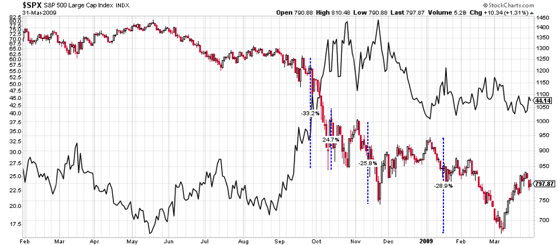Market Bottoming Process
By Shawn Gibson on Mar 31, 2020

Given the high level of uncertainty regarding COVID-19, it is impossible to estimate what the final market bottom will be. The final low water mark will be a function of a number of factors, including, but not limited to:
1) The availability of widespread rapid testing
2) The development of treatments for patients having an adverse reaction to the virus
3) The timing of businesses reopening to once again allow consumer spending
4) The magnitude of financial and fiscal stimulus to provide relief to our citizens and businesses that are struggling during this shutdown
A market bottom coming out of crisis is typically a process that takes time and requires an equilibrium to be established between investors that throw in the towel and investors that recognize extreme value and are sufficiently capitalized to take advantage of the opportunity. While there is no precedent for what we are experiencing today, examining the bottoming process of the 2008-2009 Credit Crisis might be helpful in setting expectations on how this might take place.
As the chart below shows, in late September of 2008, the major waterfall lower caused the S&P 500 Index to fall about 33% in the course of a few weeks. This decline was followed by a sharp rally of almost 25% in just a couple of trading days. While this marked a short-term bottom, it was only the beginning of a longer bottoming process. The equity markets made a new short-term low in November 2008 and then rallied into January 2009 before starting the final multi-month decline before the market made a final bottom in March 2009. The important points here are that the bottoming process will likely come with wild market swings in both directions, will likely take months to complete, and identifying the final low point will only be possible long after it takes place. One interesting point is that the CBOE Volatility Index (“the VIX”), which roughly measures estimated future equity volatility, the solid black line in the chart, actually peaked well before the market bottom. A stabilization of the VIX at lower levels might be a useful guidepost to consider as an indication of increased market stability and a sign that the bottoming process may be closer to the end rather than the beginning.

Learn more about Liquid Strategies and our offerings.
The assertions and statements in this blog post are based on the opinions of the author and Liquid Strategies. The examples cited in this paper are based on hypothetical situations and should only be considered as examples of potential trading strategies. They do not take into consideration the impact that certain economic or market factors have on the decision making process. Past performance is no indication of future results. Inherent in any investment is the potential for loss.
- October 2025 (3)
- August 2025 (1)
- July 2025 (3)
- May 2025 (1)
- April 2025 (7)
- March 2025 (2)
- February 2025 (1)
- January 2025 (1)
- November 2024 (1)
- October 2024 (1)
- July 2024 (2)
- April 2024 (1)
- January 2024 (1)
- November 2023 (1)
- October 2023 (1)
- August 2023 (1)
- July 2023 (1)
- April 2023 (1)
- January 2023 (1)
- November 2022 (1)
- October 2022 (2)
- July 2022 (1)
- April 2022 (1)
- March 2022 (2)
- February 2022 (3)
- January 2022 (3)
- November 2021 (1)
- October 2021 (3)
- September 2021 (1)
- July 2021 (1)
- May 2021 (1)
- April 2021 (1)
- March 2021 (3)
- January 2021 (3)
- December 2020 (3)
- October 2020 (3)
- September 2020 (2)
- August 2020 (4)
- July 2020 (6)
- June 2020 (4)
- May 2020 (4)
- April 2020 (4)
- March 2020 (14)
- February 2020 (9)
- January 2020 (3)
- December 2019 (1)
- November 2019 (1)
- October 2019 (1)
- July 2019 (1)
- April 2019 (1)
Subscribe
You May Also Like
These Related Posts

'We're at a pretty big inflection point' ahead of FOMC minutes, Jackson hole

The Hidden Risks of Laddered Buffered ETFs and Structured Notes

